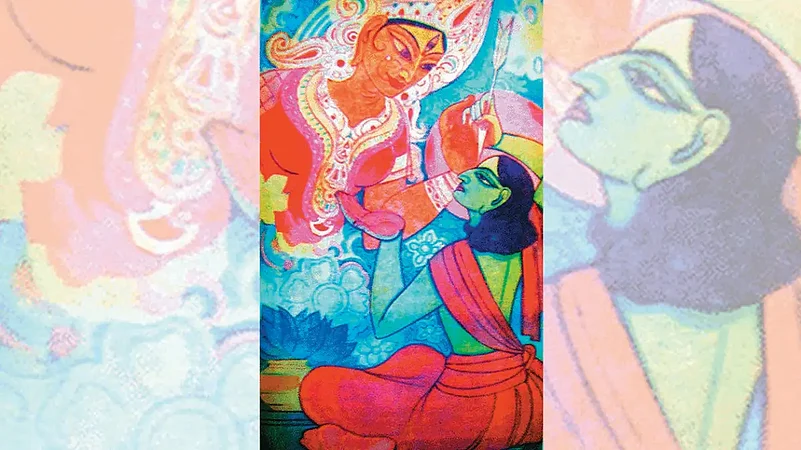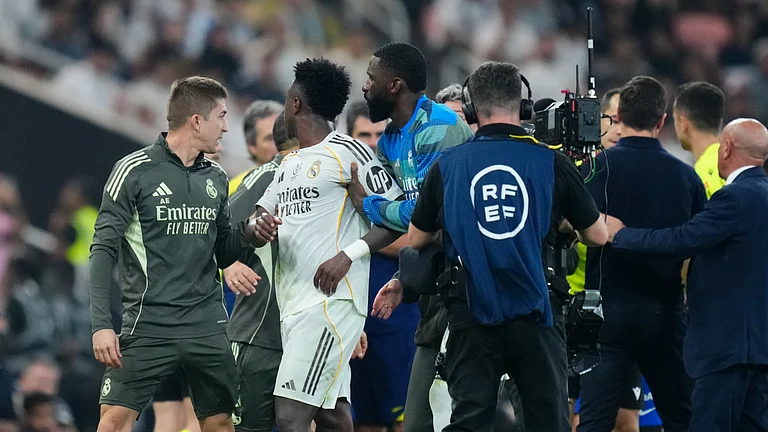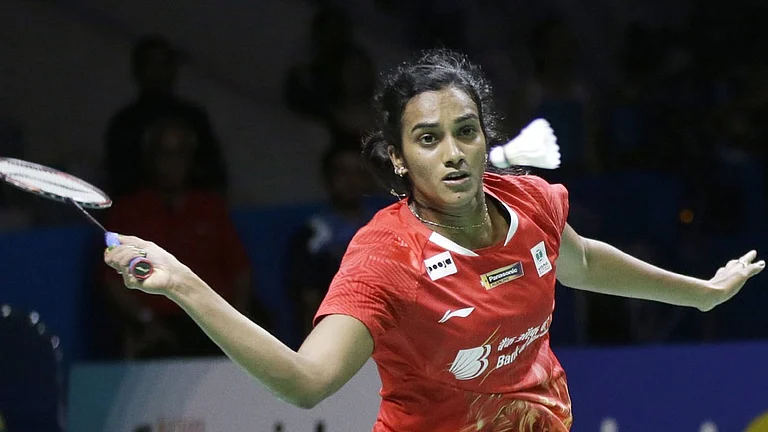After bathing in waters of the sea, those rakshasas
now headed back toward Lanka,
wet still with water of their grief—it was as if they had immersed the image of the
goddess on the lunar tenth day of the Durga Puja
Then Lanka wept in sorrow seven days and seven nights.
This is how Michael Madhusudan Dutt’s take on Ramayana, titled Meghnad Badh Kavya, the 18th-century Bengali epic, ended in American writer Clinton B. Selee’s translation, The Slaying of Meghanada. Dutt, one of the icons of the ‘Bengal Renaissance’, equated Ravan’s grief on his son Meghnad’s death with that of the bisarjan (immersion) of Durga idols on Bijoya Dashami, which in West Bengal is not the celebration of Ram’s return to Ayodhya, but a day of mourning. On this day, Durga, along with her children, returns to her husband’s abode in the Himalayas, after spending five days with the family of her birth.
The Bengal Renaissance, which began about the same time as the rise of Rammohun Roy in Calcutta’s intellectual circles in the second decade of the 19th century and the Young Bengal movement, saw Bengal’s new intellectual class breaking away from Hinduism, discarding idolatry, among other practices, and questioning everything old, from worldviews to conservative ideas. It was the scene of a raging battle between rationalism and religious conservatism.
The Ramayana, too, did not escape scrutiny. Apart from Dutt, who was a Christian, Sukumar Ray and Abanindranath Tagore of the Brahmo Samaj presented the epic in quite unconventional ways.
ALSO READ: Who Is Ram And What Is His Story?
Meghnad Badh Kavya, published in 1861, was written in blank verse that Dutt had introduced in Bengali literature a year before. The poem presented Ravan and his son, Indrajit alias Meghnad, as heroes. The tragedy is divided into nine cantos, ending with Meghnad’s death, pathos being the dominant tone.
It became a talking point soon after, drawing both appreciation and opprobrium in equal measure. Some showered it with high praise, calling it an unparalleled masterpiece, while some criticised it for the writer’s bias towards Ravan and Meghnad and still some others criticised it for its difficult-to-comprehend, highly Sanskritised Bengali.
Rajnarayan Basu, a friend of Dutt and an important figure of the Bengal Renaissance, though, held the work as a masterpiece, compared it with John Milton’s Paradise Lost. “The poet has tried his best to show his empathy for Ram, Lakshman and Sita in order to entertain the native readers, but he failed to hide his bias for the Rakshasa clan. Milton’s Satan is worthier of the title of hero than Christ. But there is a difference between Milton and our poet—Milton blundered unknowingly but our poet did it willingly… He expressed his devotion for the Rakshasas,” he said.
Villains as heroes
In his review, titled “Meghnad Badh Samporke Du-Ekti Kotha (One or Two Words About Meghnad Badh)”, published in 1881 in Bangadarshan, which was edited by Bankim Chandra Chattopadhyay, editor and critic Shrish Chandra Majumdar wrote that every Hindu grows up carrying a divine image of Ram, Lakshman and Sita, while hatred for the Rakshas clan is etched in their hearts, but Dutt managed to reverse it. In his words, “Meghnad Badh is built taking only one leaf out of Ramayana. But every reader will realise it is made of what’s not there in Ramayana. No one feels like hating the rakshashas in Meghnad Badh—that feeling never arises. On the contrary, one feels sympathetic towards Lanka, ‘a jewel on earth’, at every step.”
ALSO READ: Who Is Ram? Defining The Enigma
In 1887, Rabindranath, then 16, launched a scathing attack on Meghnad Badh in a detailed critique of the poem in his family journal, Bharati. He almost slayed Dutt for turning valorous characters like Ravan, Ram and Lakshman into ‘feminine’ and ‘weepers’. But he discarded his views on the poem two decades later, describing them as “insolent”.

Describing Dutt’s work as an “immortal poem” Tagore wrote in his memoir Jibon Smriti, published in 1912: “The text has rebellion in it. The poet has not only broken the barriers of rhyming, but has also daringly broken the stereotypes that we have created around Ram and Ravan. In this poem, Ravan and Indrajit have emerged greater than Ram and Lakshman…Ignoring the power that very carefully obeys all the rules, the Kavya-Lakshmi (poetry goddess) garlanded the power that dares obey nothing.”
A fun take
Meghnad Badh is, however, was not the sole iconic work that challenged the established Ramayana narrative. Take, for instance, Sukumar Ray’s play Lakshmaner Shaktishel (Lakshman and the Wonder Weapon), which playfully turns godly characters of the epic into something earthy and ordinary.
Here is a scene from the play, which borders on the profane and the irreverential:
(Chaos Outside)
Ram: What’s the chaos outside about?
Sugrib: Is it Ravan coming?
Bibhishan and Jambuban: What—Ravan coming? What!
Bibhishan: Where’s my umbrella? Where’s my bag?
Jambuban: Hey, you got strength? Can you carry me on your shoulder?
(The messenger enters as Jambuban tries to climb Bibhishan’s shoulder)
A few moments later in the play, as the chaos appears to be from people carrying an unconscious Lakshman to Ram’s court, Ram wails and faints. Monkeys cry, too, eating bananas in between wailing episodes. Hanuman tells Jambuban that he was not beside Lakshman when he was attacked as he was busy eating batasa (sweets made of sugar offered to deities). Jambuban imposes a fine on Hanuman and dozes off as soon as Sugrib calls for teaching Ravan a lesson.

After Ram regains consciousness, Jambuban writes a prescription for Lakshman and asks Hanuman to fetch vishalyakarani, the magic panacea. Hanuman agrees to go on the next day and suggests Jambuban to make do with homoeopathy for the day. Ultimately, Hanuman is persuaded to leave only after being bribed with bananas.
In his essay, titled Nonsense Club And Monday Club: The Cultural Utopias Of Sukumar Ray, critic Debasish Chattopadhyay says that Ray “demytholises” a serious episode from the Ramayana and “compels these legendary, heroic figures to descend from the epic heights to a world of spoof and horseplay.” He wrote, “Sukumar belittles the mythical, heroic characters by endowing them with the traits of ordinary human beings.”
Ray’s play, which was full of such absurdities, became one of the most popular pieces of children’s literature in Bengal since its publication in 1924, about a year after Ray’s death at the age of 37. In 1987, Sukumar’s more famous son, filmmaker Satyajit, arranged for an enactment of the play to include scenes in his documentary on his father.
Ahead of its time
Abanindranath Tagore, one of the pioneers of modern art in India, wrote Khuddur Jatra, alternatively called Khudi Ramleela, in 1934–35 for his grandson. Written in the style of Jatrapala, a loud form of musical theatre popular mostly in rural Bengal, the book did not change the basic narrative. The author juxtaposed the text with a wide range of visuals taken from modern printed material.
What was the most extraordinary about the book is that Abanindranath interspersed the narrative with cut-ups from reports and headlines in newspapers—Bengali and English advertisements of materials ranging from shoes and insurances to petrol, cigarettes and cosmetics; photographs, drawings and paintings of landscapes; dance and theatre performances; sports, airfields, aircrafts, bombing, war, living and dead birds and animals; sumptuous vegetarian and meat dishes; men drinking in a bar; and pages from European comic strips.
ALSO READ: Lesson On Environment From Ramayan
For example, the inscription ‘Sitaharan’ (abduction of Sita) appears below a poster of the 1935 Hindi film, Hind Kesari, depicting a horse rider. The text deals with Surpanakha appearing before Ravan in his court at Lanka her nose and ears cut. As an angry Ravan leaves to abduct Sita, Kumbhakarna rebukes Surpanakha for “stooping to chase a man” and suggests to her to apply Boroflex, an antiseptic cream popular in early 20th-century Bengal, to her nose and ears.
In page 125, a photo of women posing around a pool, titled “Bathing Beauties in ‘Roman Scandal’,” accompanies the text where the trio of the narrators, Khudiram, Kenaram and Becharam, sing the glories of Ravan’s pleasure garden. In page 139, where the text deals with the building of the bridge to Lanka by Nala, Neela and Hanuman, an advertisement of Rohtas Cement appears with the catchline: “For strength and durability.”
“There is nothing irrelevant or inessential in the work,” artist and critic Ramananda Bandyopadhyay wrote about it. However, the work came in public knowledge after seven decades when it was published in 2009, along with an English translation by Samik Bandyopadhyay.
Abanindranath wrote several texts based on the Ramayana for children where the dialogues and characters were often funny.
In his piece, titled The Craft of Whimsy, Sankha Ghosh, one of the major postcolonial Bengali poets and a Jnanpith awardee, wrote that Khuddur Jatra was different in its treatment. “[It] was not always a spirit of fun that motivated Abanindranath, but more often than not it was a critical mind at work, snapping at times at developments in the national and international political scenario,” Ghosh said.
However, tweaking the Ramayana did not hurt religious sentiments.
Those were different times, then.
(This appeared in the print edition as "A Radical Recast")


























